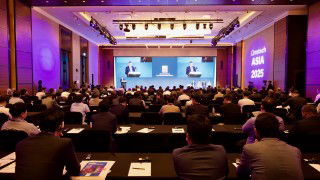Cemtech Conferences and Exhibitions successfully concluded its ninth Middle East and Africa (MEA) meeting over 2-5 February 2014 at the Grand Hyatt Dubai, UAE, a highly-popular choice of destination as confidence returns to the country’s construction and cement sectors. With an air of optimism surrounding most MEA markets, the meeting drew an audience of over 270 delegates from 36 countries, all keen to pool information and exchange ideas on how to achieve operational excellence in this dynamic region.
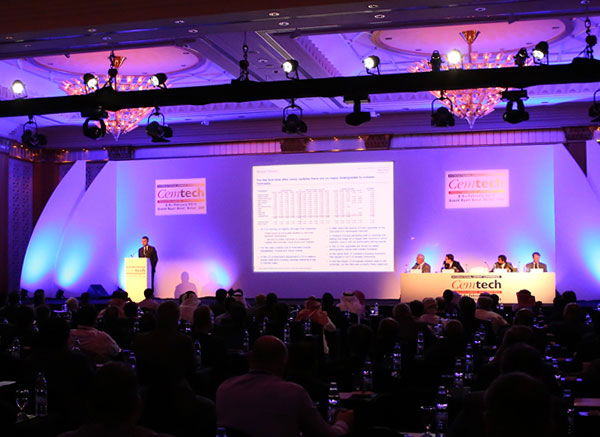
Cemtech Middle East & Africa welcomes 270 delegates from 36 countries
stretching across the Middle East, Africa and beyond
In the presence of Guest of Honour, His Excellency Sheikh Yaser Al Qasemi, General Manager of Union Cement Company and Chairman of the Cement Producers’ Association of the UAE, conference proceedings officially commenced with an address from Cemtech organiser, Thomas Armstrong, giving an overview of cement industry developments in MEA markets. Underlining the resilience of the region in the face of a challenging political environment, he said: “Even in Egypt, where increased competition and skyrocketing energy costs have been compounded by a weakening market resulting from political unrest, demand has fallen only modestly, while other countries such as Algeria are performing well.”
The keynote speech by Yuri Serov of Morgan Stanley (UK) provided a timely outlook for global cement markets in 2014 with an improving growth rate antipated. “After a significant slowdown in 2013 (ex-China) cement consumption is set to re-accelerate,” Mr Serov noted. The research house expects cement consumption to rise about 3.3 per cent in 2014, adding about one percentage point to the expansion rate for the year. Roughly half of the advance is explained by a gradual bottoming in western Europe where after a small, final fall the adjustment should be completed this year.
Improved trends are forecast in India, Egypt and Mexico while ups and downs can be expected across many other markets. Higher growth is anticipated in emerging markets but is unlikely to exceed half the level of the pre-crisis peak, he added.
GCC: returning to form
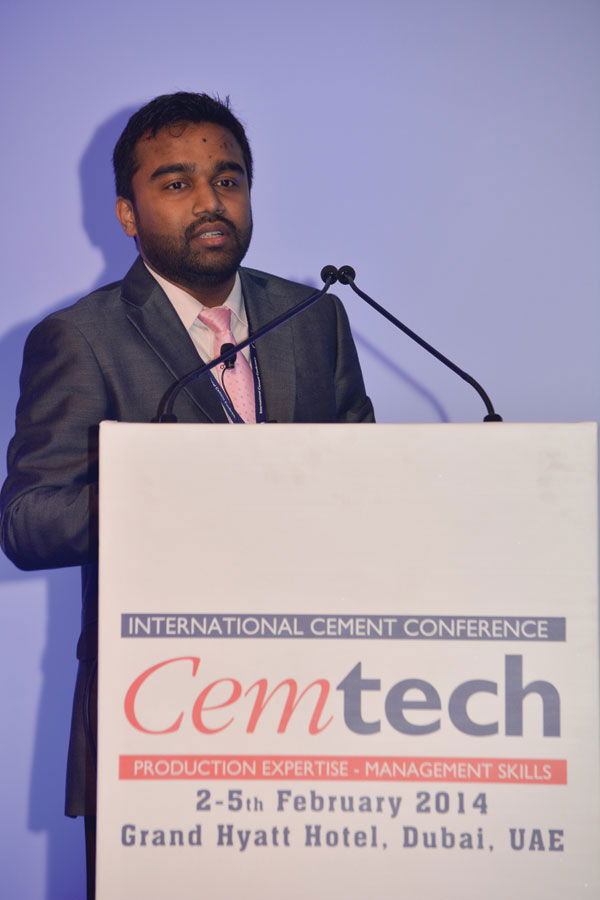
“Development plans worth billions of dollars will keep
cement demand progressing well in the GCC.”
Hettish Karmani Global Investment House (Kuwait)
“Development plans worth billions of dollars will keep cement demand in GCC markets progressing well,” stated Hettish Karmani of Global Investment House (Kuwait) during his analysis of the Gulf cement sector. Projects will be driven by national development plans, the Qatar 2022 FIFA World Cup and Dubai World Expo 2020 – amounting to a potential construction value of US$2.4trn in the coming years.
While Saudi Arabia will remain by far the largest market, Mr Karmani expects Qatar to exhibit the highest growth rate, with consumption forecast to rise to an average of 7Mta over 2013-22. Moreover, he emphasised the “opportunities for neighbours once World Cup-related contracting picks up pace.”
Meanwhile, the emerging recovery underway in the UAE is particularly significant, led by a rebound in the real estate sector and government support for the infrastructure and non-residential segments. According to Mr Karmani, the market is primed for further growth, adding that: “A sizeable pick-up in the UAE post-2015 is quite possible.”
Untapping potential
Analysis of other important high-growth markets included an in-depth presentation by Trond Waerp of Africa Consulting Services (Norway) who explored the evolution of supply and demand in west Africa. Demand in this region has doubled during the past decade and growth is expected to continue, fuelled by general economic advances and a focus on infrastructure investments. This has led to heavy investment in new cement capacity, notably in Nigeria, resulting in an oversupply situation at present. By 2016 Mr Waerp forecasts clinker and cement surpluses to reach 12Mt and 25Mt, respectively. Nevertheless, high growth rates, particularly in Nigeria, could see this surplus being absorbed in a few years.
Afghanistan’s untapped potential was the focus of a presentation by Preeth Gowdar of The Task Force for Business and Stability Operations (USA) as investor opportunities begin to open up for those seeking to enter this re-emerging market. Today, Afghan cement demand is estimated to be 6Mt and consists almost entirely of imports. With consumption expected to rise by 10 per cent over the 2012-14 period and 25-35 per cent over 2014-17, domestic production is unsubstantial in relation to overall demand. With the government keen to attract inward investment, Mr Gowdar outlined some of the inroads being offered to investors looking to tap into the country’s wealth of natural resources.
A topical presentation by Soumen Karkun of Holtec Consulting (India) presented a roadmap to strategic capacity creation in the booming Saudi market, in which he highlighted the need to consider alternative raw materials, such as feldspar, to extend viable resources.
Greenfield successes in full swing
Moving on to the completion of recent greenfield plants in the MEA region, Giorgio Bodo, CEO of ASEC Cement (Egypt), gave a fascinating insight into the challenges faced during the construction of the company’s 2Mta Minya plant in Egypt. The timing of the plant’s construction was unfortunate, in that it coincided directly the Egyptian Revolution. However, despite working in a very difficult context, the project was finalised in a remarkable 30 months. “We launched the project at the best-possible time, and we managed and completed it under the worst-possible circumstances,” Mr Bodo explained.
Clinker and cement production at Minya successfully started on 10 and 27 June 2013, respectively, and cement sales started at the end of September. The current dispatch rate is 4300tpd with product mainly sold in Upper Egypt. Recent milestones include a daily clinker production record of 5800t last December – 300t more than nominal capacity. Also on the same day, 5500t of cement were ground by one mill, setting another daily record and achieving 500t more than nominal capacity.
From Egypt’s newest cement plant to Ethiopia’s largest production line, Dawit Getachew shone a spotlight on operational experiences of the Derba Midroc cement works and its impact on the domestic market. The greenfield facility was built on an EPC contract basis by China National Building Material Co (CNBM) with a 5000tpd clinker line and cement capacity of 7000tpd. Mr Getachew highlighted that since entering the market in 2012, the plant has not only helped meet market requirements but also stabilise cement prices.

Delegates listened with interest to the latest developments in the region's cement industry
Construction of the world’s first white/grey dual-process cement plant at Fujairah was the focus of a presentation by Alok Agarwal of JK Cement Works Fujairah, UAE. The so-called ‘swing plant’, built in technical collaboration with Taiheiyo Engineering Corporation, has a white and grey cement capacity of 0.6Mta and 1Mta, respectively, from a single kiln line. Mr Agarwal noted that the innovative switch-over technology employed enables a quick changeover from one product to another and considers all critical activities like switching of clinker cooler, etc.
Cutting-edge technology case studies
In another industry ‘first’ Mohamed Saad of Saudi Readymix (SRMCC) detailed the successful implementation of the first ‘Plug & Grind®’ mobile slag grinding plant by Cemengal of Spain. P&G process technology is based on a ball mill grinding facility compacted into eight standard containers which makes it easy to transport and fit into SRMCC’s different locations. Installation works were completed in 25 days and commissioning in a further 60 days. Achieving the performance acceptance certificate (PAC) volume required one simple on-site modification, after which, the mill exceeded the guarantee volume of 7tph for GGBFS production at 4000Blaine.
Kalyan Bose of Yanbu Cement shared some of the results achieved following conversion projects on Kiln Line 4 of its plant in Saudi. Conversion of the clinker cooler baghouse to ESP was commissioned in October 2011 and has since seen clinker temperatures fall from 200°C to 120-130°C, a reduction in dust emissions, more stable kiln operation and emissions below 15mg/Nm³. The conversion of the bypass ESP to baghouse, commissioned in December 2012, has also eliminated material build-up in the ESP hopper and chambers. Smooth kiln operations are now being achieved and emissions are maintained at below 10mg/Nm³. Yanbu is also in the midst of converting its raw mill and kiln main ESP to baghouse technology with expected commissioning by year-end.
Trading developments
In a session dedicated to trading, Ad Ligthart of Cement Distribution Consultants (The Netherlands), gave an overview on the seaborne trade and distribution of cement and clinker, with a specific look at import and export terminals in the Gulf area.
Also under this umbrella came a presentation by Joel Grau of Clarksons on dry bulk cement freight markets. He underlined that global cement seaborne trade is recovering. Expectations going forward are that freight markets will improve over the next two years and freight rates are forecast to increase.
Improving maritime logistics was the theme of a paper by Wolfgang Schlüpmann of Haver & Boecker who explained how process automation and dispatch management systems, such as the Haver Control, can manage and optimise sub-processes (ie, mixing, packaging, shipping, storage), and provide data for further processing.
Energy, fuel & power initiatives
Osama Anis of Cemex enlightened delegates on how the global cement major has been transferring its alternative fuels experience to its Assiut Cement operations in Egypt. To address the problem of weak waste management in the Assiut area, Cemex collects municipal waste and undertakes preliminary processing before transporting it to its cement plant for use as alternative fuels. Since 2011, Cemex Egypt has doubled its AF usage from 111,435t to 230,084t in 2013, helping the company to reduce CO2 emissions and tackle the issue of energy constraints. The strategy has opened up opportunities for the safe disposal of waste in the country, and today Cemex is the “largest recyler of waste in Egypt with >230,000t recycled annually,” Mr Anis explained.
With increasing amounts of solid waste available as a potential fuel source in Middle East and African countries, Henrik Mønsted Schmidt of FLSmidth focussed on the company’s Hotdisc technology for burning solid lumpy fuels, and highlighted references around the world, including North Africa.
Muayad Matar of Najran Cement (Saudi Arabia) provided a project update on the company’s first waste heat recovery (WHR) facility currently under implementation. Work is progressing smoothly and the boilers are due for commissioning in a phased manner over the first half of 2014. The project will enable Najran to save approximately 37,200,000l of heavy fuel oil while CO2 emissions will be reduced by 145,000tpa.
Sharad Thattey and Mukesh Birla of Birla Cement also took to the Cemtech stage to explain how the India-based producer has been lowering energy costs at its Chittorgarh plant in Rajasthan through the installation of a 9MW steam-based WHR system.
Meanwhile, in the UAE, National Cement Co (NCC) decided to make the transition from oil to pulverised coal to lower production costs at its Dubai plant. Hassan Jradi of FLSmidth described how the dosing Rotor weighfeeder Pfister® DRW, FLSmidth Duoflex® burner has helped NCC ensure precise coal dosing, burning and stable kiln firing.
Advances across the entire production chain
The conference continued with a range of presentations focussing on all areas of cement manufacturing. Contributions included a paper by Per Åström of Bosch Rexroth Sweden on how the retrofit of kiln drives can lead to higher and more reliable production rates.
A presentation by Carsten Wiedmann of Thermo Fisher Scientific looked at the benefits XRD technology can bring to improving cement resistance as well as providing a better picture of clinker phases. He also explored the advantages of XRF instruments during the analysis of alternative fuels.
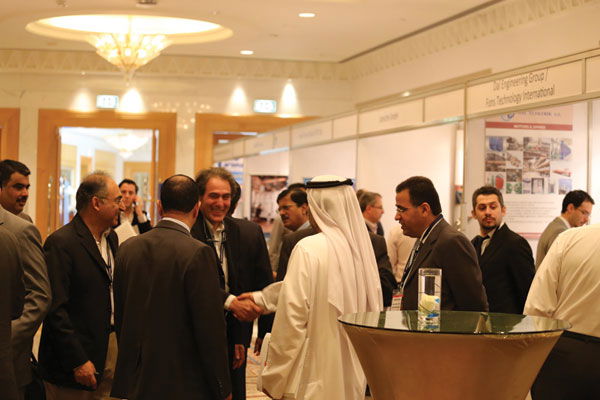
An international exhibition brimming with industry discussions provided the ideal forum for delegates
to create new business opportunities and strengthen existing relationships
Versatile vertical roller mill (VRM) technology was the subject of a presentation by Loesche which has recently been awarded the order for Saudi Arabia’s first VRM for cement grinding. Southern Province Cement Co (SPCC) has selected the German grinding specialist to supply two LM 56.3+3 VRMs for a new line at its Bisha works. The new mills will enable SPCC to adapt to changing market demands, allowing it to produce OPC cements as well as various additive cements with differing product finenesses.
Continuing the grinding theme, Necdet Kaya of Idea Kimya looked at the effect of new-generation cement additives on particle size distribution which can lead to energy savings in grinding and enhanced concrete performance.
Advanced conveying, filling and loading technologies were discussed by Andre Tissen of Beumer. And finally, Mark van der Merwe of BillerudKorsnäs wrapped up conference proceedings by explaining how to improve the commercial and technical performance of paper sack packaging.
Extended programme
An extended technical programme gave delegates the opportunity to tour one of the UAE’s newest cement plants (see box story). Meanwhile, a half-day workshop on ‘Strategies for fundamental cost minimisation’ hosted by Dr Michael Clark, International Cement Review’s Technical Consultant, explored the different options and technologies companies can pursue to achieve greater efficiencies and cost reductions.
Al-Ain plant tour |
|
| As part of an extended technical programme, delegates were able to tour the state-of-the-art Al-Ain Cement works, kindly organised by plant owner Arkan Building Materials. One of the largest cement facilities in the UAE, the Al-Ain works comprises a single 11,000tpd kiln line with a clinker and cement capacity of 3.1Mta and 4.5Mta, respectively. Commissioned in December 2012, the plant is also setting new environmental standards by using natural gas, helping to lower overall operational costs, improve energy efficiency and reduce its carbon footprint. Going forward, the plant is primed to play a significant role in the upturn in domestic construction. activity currently underway. |
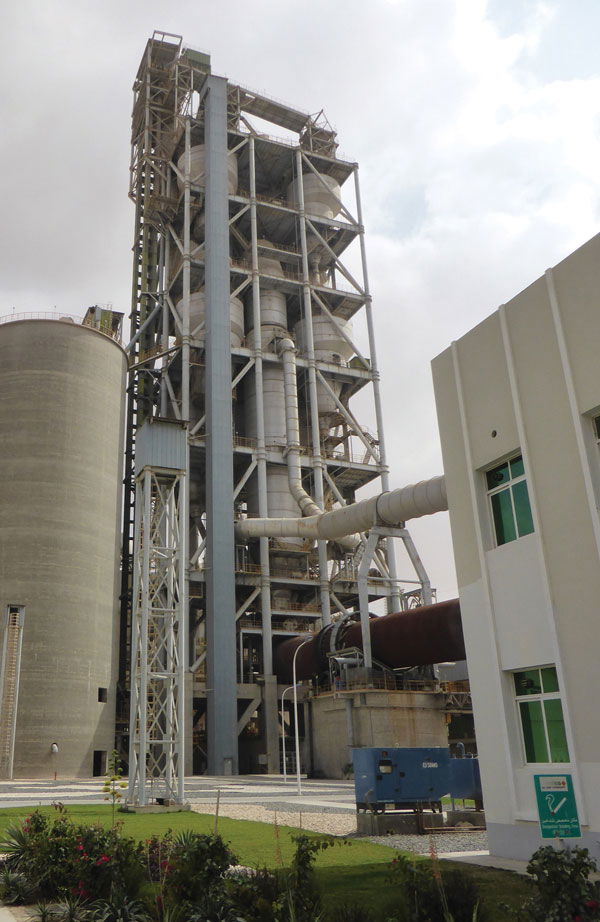 |
Arabian days and nights

A Gala Dinner under the stars marks the close of another successful Cemtech Middle East & Africa meeting
The highest Cemtech hospitality levels were extended throughout the three-day event including a complimentary sightseeing tour for accompanying partners to many of Dubai’s cultural attractions.
Meanwhile, lunches and evening receptions within five-star luxury surroundings of the Grand Hyatt Dubai provided delegates with additional networking opportunities. A Gala Dinner closed proceedings with a final flourish as guests enjoyed an al-fresco feast accompanied by traditional Arabian entertainment under the Dubai night sky.
Cemtech Conferences & Exhibitions looks forward to returning to the region early in 2015. For details of our forthcoming Cemtech Asia event, visit: www.Cemtech.com/Asia2014. Article first published in International Cement Review, April 2014.
